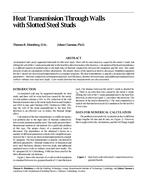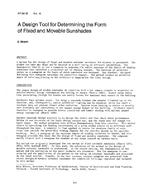Significant energy losses associated with HVAC ductwork located in a house attic have resulted in a proposed attic design called the “cathedralized attic.†In this design, the attic floor insulation is replaced by insulation located against the bottom of the roof deck, and no outside ventilation to the attic space is permitted. This approach offers both advantages and disadvantages. Previous researchers have reported on how these attics perform in hot, dry climates using a whole building simulation tool. The analysis reported here uses a computer model of heat transfer within the attic space to examine the net effect of this approach compared to a traditional attic in six different climates. Parametric analysis was used to explore the effect of climate, varying levels of attic insulation, and different duct details. These duct details included length, leakage rate, insulation level, and HVAC run time. The computer model includes radiative heat exchange, as well as conductive and convective heat transfer modes and has been previously benchmarked against experimental data.
Citation: Thermal Performance of Exterior Envelopes of Whole Buildings IX
Product Details
- Published:
- 2004
- Number of Pages:
- 15
- File Size:
- 1 file , 6.6 MB
- Product Code(s):
- D-BldgsIX62


